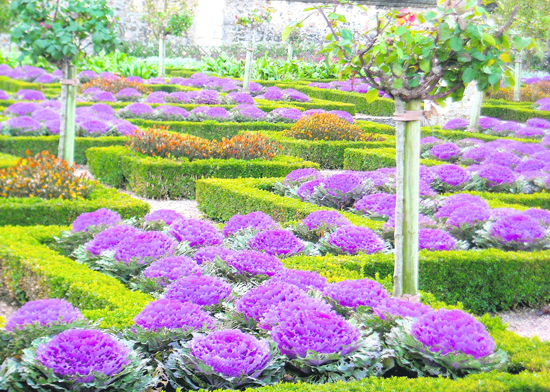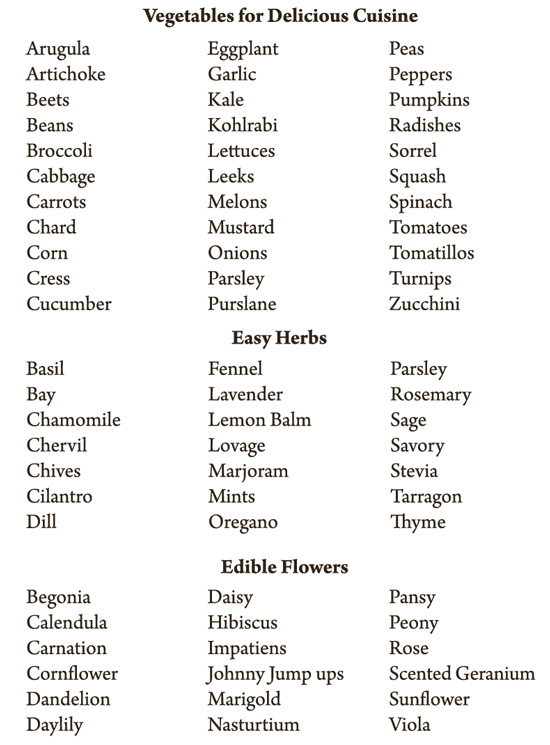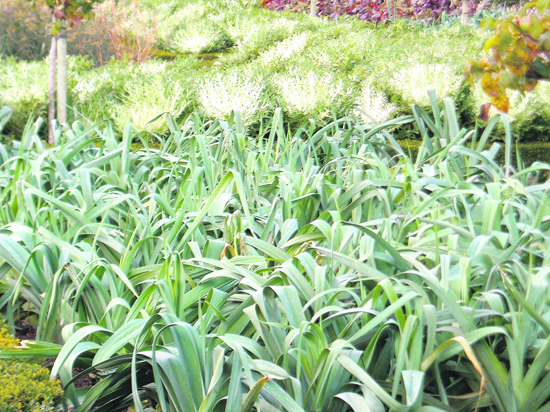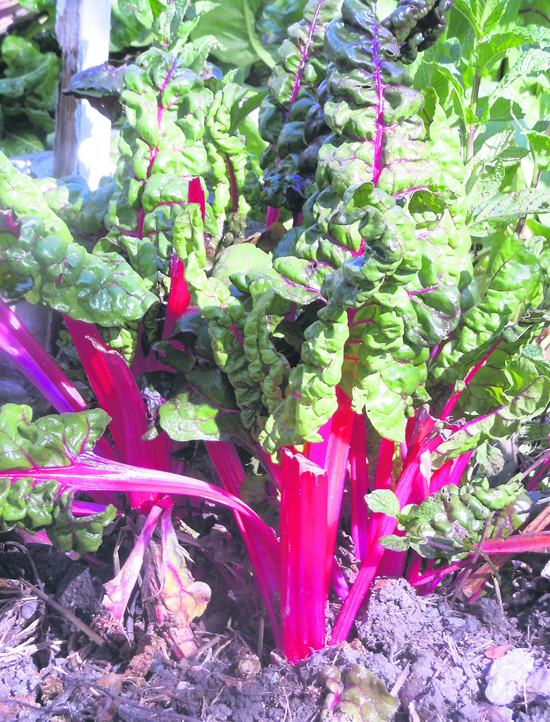 | | | The magnificent formal potager at Chateau Villandry in France with purple kale, tree roses, and peppers edged with clipped boxwood. Photos Cynthia Brian
| | | | | |
After two weeks of pulling weeds, hauling manure, spading, triple digging, and finally sowing seeds, my nails are nubs and my back is aching. Yet, I am exuberant for the harvest that will begin soon as a result of my newest experiment-planting my personal potager.
 Potager is a French word for a manner of gardening mixing flowers with vegetables, fruit, berries, and herbs in a formal style. If you want fresh, succulent, and abundant produce straight from the garden to the table, planting a potager is the smartest garden practice to adopt.
Potager is a French word for a manner of gardening mixing flowers with vegetables, fruit, berries, and herbs in a formal style. If you want fresh, succulent, and abundant produce straight from the garden to the table, planting a potager is the smartest garden practice to adopt.
 Americans are used to planting vegetable gardens, the English plant kitchen gardens, and the French have potagers. Since the Middle Ages, the French have been combining anything they want for decor or culinary delights in one garden plot. The advantage of a potager is that this type of cultivating is ideal for any plot size. It saves space, nutrients, and water, all the while adding a bountiful beauty to your landscape. A glorious Renaissance chateau in France, Villandry, is considered one of the world's most famous potagers with acres of formal beds divided into nine equal squares, edged with boxwood and changed seasonally. Artichokes, leeks, cabbages, pumpkins, peppers, beets, Swiss chard, squash share space with roses, nasturtiums, catmint, marigolds, and violas. The plan has been replicated and copied all over the globe.
Americans are used to planting vegetable gardens, the English plant kitchen gardens, and the French have potagers. Since the Middle Ages, the French have been combining anything they want for decor or culinary delights in one garden plot. The advantage of a potager is that this type of cultivating is ideal for any plot size. It saves space, nutrients, and water, all the while adding a bountiful beauty to your landscape. A glorious Renaissance chateau in France, Villandry, is considered one of the world's most famous potagers with acres of formal beds divided into nine equal squares, edged with boxwood and changed seasonally. Artichokes, leeks, cabbages, pumpkins, peppers, beets, Swiss chard, squash share space with roses, nasturtiums, catmint, marigolds, and violas. The plan has been replicated and copied all over the globe.
 Potagers are mostly filled with annuals as opposed to permanent plantings of perennials to allow for rotation and choice. The secret is to blend plants that are edible or are useful as natural pest and insect resistors. When creating your Lamorinda potager, start by drawing a design for the beds. A central focal point such as a small tree, decorative frame, a bean teepee, or a dramatic plant such as a globe artichoke sets the stage. The pattern is more effective when you plant generously for an opulent outcome while choosing specimens carefully. Each vegetable, herb, berry, fruit, or flower is meant to shine individually while complementing the looks or habits of its neighbors. Aim for symmetry and balance, planting in patches or clumps as opposed to rows.
Potagers are mostly filled with annuals as opposed to permanent plantings of perennials to allow for rotation and choice. The secret is to blend plants that are edible or are useful as natural pest and insect resistors. When creating your Lamorinda potager, start by drawing a design for the beds. A central focal point such as a small tree, decorative frame, a bean teepee, or a dramatic plant such as a globe artichoke sets the stage. The pattern is more effective when you plant generously for an opulent outcome while choosing specimens carefully. Each vegetable, herb, berry, fruit, or flower is meant to shine individually while complementing the looks or habits of its neighbors. Aim for symmetry and balance, planting in patches or clumps as opposed to rows.
 I bordered my terraced potager with sunny colored calendulas, also known as pot marigolds, using the bright orange petals in salads for a fresh snappy taste, and in cooking as a poor man's saffron. Armenian cucumbers are being trained on a tripod I made from pear tree trimmings along with scarlet runner beans. Two large artichokes anchor one corner of the potager where fennel, parsley, and onions nestle beneath the large fronds. A dwarf volunteer apple tree (with the most delicious crunchy apples) proudly grows on the other side planted with sprawling strawberries, mounds of potatoes, squares of basil and beets. Once sprouted, peppery nasturtiums will spill over the raised edges meeting the thyme growing between the steppingstones, the hues mingling boldly with the variety of lettuces, carrots, spinach, and eggplant. Seven varieties of grapes are trellised along the fence with rosemary as ground cover and black currents as end pillars.
I bordered my terraced potager with sunny colored calendulas, also known as pot marigolds, using the bright orange petals in salads for a fresh snappy taste, and in cooking as a poor man's saffron. Armenian cucumbers are being trained on a tripod I made from pear tree trimmings along with scarlet runner beans. Two large artichokes anchor one corner of the potager where fennel, parsley, and onions nestle beneath the large fronds. A dwarf volunteer apple tree (with the most delicious crunchy apples) proudly grows on the other side planted with sprawling strawberries, mounds of potatoes, squares of basil and beets. Once sprouted, peppery nasturtiums will spill over the raised edges meeting the thyme growing between the steppingstones, the hues mingling boldly with the variety of lettuces, carrots, spinach, and eggplant. Seven varieties of grapes are trellised along the fence with rosemary as ground cover and black currents as end pillars.
 Tomatoes, jalapenos, and white corn will dominate the sunniest spots with sunflowers standing guard.
Tomatoes, jalapenos, and white corn will dominate the sunniest spots with sunflowers standing guard.
 The patchwork of legumes, vegetables, herbs, flowers, and fruit engaged in a system of succession sowing is decorative in shape, form, color, and texture while being functional in providing quantities of the freshest produce throughout the year. The key element to the high drama of a potager is to create a plan for what you enjoy, then, dig in.
The patchwork of legumes, vegetables, herbs, flowers, and fruit engaged in a system of succession sowing is decorative in shape, form, color, and texture while being functional in providing quantities of the freshest produce throughout the year. The key element to the high drama of a potager is to create a plan for what you enjoy, then, dig in.

 
 Cynthia Brian's Gardening Guide for May
Cynthia Brian's Gardening Guide for May
 "To forget how to dig the earth and to tend the soil is to forget ourselves." - Mahatma Gandhi
"To forget how to dig the earth and to tend the soil is to forget ourselves." - Mahatma Gandhi

 The blossoms from the apples, pears, and cherries are almost spent while the buckeye, chestnut, dogwood, and red bud trees flaunt lightning bolts of color. The heady fragrance of lilac shares a beautiful balance with bearded iris, rose, and wisteria as they brighten with a repetition of color moving the eye in soft waves throughout the landscape. Butterflies and bees flock to these plants creating a fluttering pollination habitat. With the warmer weather, we'll need to watch our water consumption. Scientists at the University of Twente in the Netherlands found that producing one rose bloom requires three gallons of water. With your new potager kitchen garden, you'll save water while enjoying exuberant edibles including flowers and herbs. Time to play. Hurray, it's May! The blossoms from the apples, pears, and cherries are almost spent while the buckeye, chestnut, dogwood, and red bud trees flaunt lightning bolts of color. The heady fragrance of lilac shares a beautiful balance with bearded iris, rose, and wisteria as they brighten with a repetition of color moving the eye in soft waves throughout the landscape. Butterflies and bees flock to these plants creating a fluttering pollination habitat. With the warmer weather, we'll need to watch our water consumption. Scientists at the University of Twente in the Netherlands found that producing one rose bloom requires three gallons of water. With your new potager kitchen garden, you'll save water while enjoying exuberant edibles including flowers and herbs. Time to play. Hurray, it's May!

 - WELCOME the migrating birds back to your garden by providing plenty of fresh water, food, shelter, and a place to nest. - WELCOME the migrating birds back to your garden by providing plenty of fresh water, food, shelter, and a place to nest.
 - KEEP up with the weeds. Pull by hand when they are small and add to your compost pile. - KEEP up with the weeds. Pull by hand when they are small and add to your compost pile.
 - EMPTY standing water from all containers, downspouts, or saucers (pour in your pots) to prevent the 23 kinds of mosquitoes from - EMPTY standing water from all containers, downspouts, or saucers (pour in your pots) to prevent the 23 kinds of mosquitoes from
 breeding and biting (According to breeding and biting (According to
 Vector Control, mosquitoes mature in five days and travel up to twenty miles.)
Vector Control, mosquitoes mature in five days and travel up to twenty miles.)
 - ATTRACT bees, hummingbirds, butterflies, and other pollinators to your garden by planting nectar producing specimens including - ATTRACT bees, hummingbirds, butterflies, and other pollinators to your garden by planting nectar producing specimens including
 flowering culinary herbs, poppies, salvias, and sunflowers. flowering culinary herbs, poppies, salvias, and sunflowers.
 - WEAR boots while gardening and hiking. Snakes are in abundance this year, including rattlers. - WEAR boots while gardening and hiking. Snakes are in abundance this year, including rattlers.
 - EXPERIMENT with what we call a weed but is really a plant packet of Omega 3's, vitamin A and C by sowing purslane in your potager. - EXPERIMENT with what we call a weed but is really a plant packet of Omega 3's, vitamin A and C by sowing purslane in your potager.
 - CHECK health and safety issues before planting a tree. Is it the right tree for the right place? Precautions include those for utilities, fire safety, height restrictions, root - CHECK health and safety issues before planting a tree. Is it the right tree for the right place? Precautions include those for utilities, fire safety, height restrictions, root
 damage potential, toxicity, and biogenic emissions.
damage potential, toxicity, and biogenic emissions.
 - ALLOW narcissus, daffodil, and tulip foliage to dry to a crunchy golden brown before cutting back. You are feeding the bulb for next season's show. - ALLOW narcissus, daffodil, and tulip foliage to dry to a crunchy golden brown before cutting back. You are feeding the bulb for next season's show.
 - BAIT for snails and slugs, especially when the seeds are sprouting. - BAIT for snails and slugs, especially when the seeds are sprouting.
 - CLEAR the last of the remaining fallen camellias from around your bushes. - CLEAR the last of the remaining fallen camellias from around your bushes.
 - TALK to your plants. Bloom, baby, bloom! It works for me! - TALK to your plants. Bloom, baby, bloom! It works for me!
 - MOW the grass weekly and give one last shot of nitrogen before the weather warms. - MOW the grass weekly and give one last shot of nitrogen before the weather warms.
 - BRIGHTEN your shady areas by planting bleeding heart, astilbe, or big root geranium. Despite what - BRIGHTEN your shady areas by planting bleeding heart, astilbe, or big root geranium. Despite what
 you may read, deer do eat geraniums!
you may read, deer do eat geraniums!
 - CLEAN sheds, potting benches, or your garage to make room for summer projects. - CLEAN sheds, potting benches, or your garage to make room for summer projects.
 - PICK sprays of sweet peas and roses from your garden for a Mother's Day fragrant posy present. - PICK sprays of sweet peas and roses from your garden for a Mother's Day fragrant posy present.
 - ADD structure with shrubs such as smokebush or spirea. - ADD structure with shrubs such as smokebush or spirea.
 - EXPLORE new colorful annuals at your local garden center including the tall spires of self-seeding ver - EXPLORE new colorful annuals at your local garden center including the tall spires of self-seeding ver
 bena bonariensis, or heliotrope to perfume the evening air.
bena bonariensis, or heliotrope to perfume the evening air.
 - BUY a California grown living plant for Mother's Day. According to the February 2011 Smithsonian - BUY a California grown living plant for Mother's Day. According to the February 2011 Smithsonian
 magazine, the majority of bouquets purchased by Americans are grown, designed, and packaged overseas. magazine, the majority of bouquets purchased by Americans are grown, designed, and packaged overseas.
 When buying bouquets, look for the Rainforest Alliance Certification which observe strict sustainability When buying bouquets, look for the Rainforest Alliance Certification which observe strict sustainability
 requirements of their floral farms.
requirements of their floral farms.
 - COME to the Be the STAR You Are!(r) charity car wash on Saturday, May 14th, 10- - COME to the Be the STAR You Are!(r) charity car wash on Saturday, May 14th, 10-
 4pm at the STAR Gas Station on the corner of Rheem Blvd. and Moraga Rd., 4pm at the STAR Gas Station on the corner of Rheem Blvd. and Moraga Rd.,
 adjacent to the Moraga Faire for a spring cleaning. Receive a FREE bag of adjacent to the Moraga Faire for a spring cleaning. Receive a FREE bag of
 fragrant homegrown and hand made potpourri.
fragrant homegrown and hand made potpourri.
 - EXPERiENCE the beauty of the blossoms by sharing a Mother's Day picnic - EXPERiENCE the beauty of the blossoms by sharing a Mother's Day picnic
 in your backyard with your Mom and family.
in your backyard with your Mom and family.

 Sending big hugs to the most wonderful women of Lamorinda-MOMS!
Sending big hugs to the most wonderful women of Lamorinda-MOMS!

 Wishing you a joyous, sun filled Mother's Day.
Wishing you a joyous, sun filled Mother's Day.
 Happy Gardening to You!
Happy Gardening to You!

|



